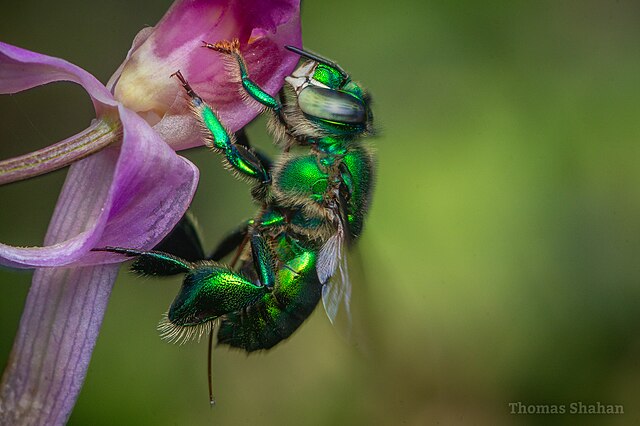Young orchid bees create a precious collection of fragrances

To seduce females, male orchid bees release a self-made perfume during courtship. Young males are the most fanatical perfume makers, Jonas Henske and Thomas Eltz write.
A beautiful colour with a metallic sheen appears to be insufficient for male orchid bees to impress females. They must also have an attractive scent. Orchid bees (Euglossini, about two hundred species) are found in tropical America. They do not live in colonies, like the honeybee. Males occupy a territory and try to attract females.
A wonderful smell is provided by a self-made perfume, which consists of a mixture of scents that males collected from flowers, rotting wood, sap from trees and – weird enough – faeces. Males differ in the intensity and complexity of their perfume, and only a few males have an outstanding blend. That’s no wonder, because it takes a lot of time and energy to find and collect the dozens of aromatic components, most of which are scarce. Young bees in particular work fanatically to concoct their perfume, as Jonas Henske and Thomas Eltz discovered during their research on Euglossa imperialis in Costa Rica. Males of this species can live for six weeks to three months.
Complex mixture
Hundreds of species of orchids benefit from the male orchid bees’ urge to collect scents. They are pollinated exclusively by these bees, in exchange for a precious fragrance.
Males capture volatile odours by spitting lipids onto a sweet-smelling surface. The fragrances are absorbed by the lipids. The bees then use their legs to stuff the scented fat into special pouches on their hind legs. They regularly take out the content to enrich it with new odours, creating an extensive and complex mixture of fragrances.
A male that wants to mate makes hovering flights in his territory, moving his legs in a characteristic way. Underneath its body, the right and left middle legs alternately sweep the pouches of the opposite hind leg. Tufts of hair on the middle legs absorb some fat. The fluttering wings then spread the perfume that is released.
Experiments in the lab showed that females are interested. The perfume allows them to determine whether they are dealing with a male of their own species; each species of orchid bee has its characteristic scent bouquet. The species Euglossa dilemma and Euglossa viridissima, for example, look similar, but can be distinguished by smell. This indicates that the males carefully compose their scent mixture: all components in exactly the right proportions.
Improvement
The researchers had assumed that the oldest male orchid bees would have the largest supply and the most complex perfume, because they had had the most time to create it. Such a precious perfume would be evidence that its owners had lived a long time, a signal of good hereditary quality and good condition. But that idea turns out to be wrong.
To test their assumption, Henske and Eltz attracted Euglossa imperialis males, captured them, estimated their age, and sealed the perfume pouch on the right hind leg with glue. They then released the animals and waited for them to reappear at the original capture site. Half of the males returned within five days, some stayed away for more than twelve days. The researchers could capture about a third for the second time, and then they compared the contents of both perfume pouches.
Between the first and second measurement, young males had improved the perfume in the pouch on the left hind leg, which had been left open: the supply had become larger, and the perfume had a more varied composition than that in the sealed right pouch. The perfume in the left pouch of old males had deteriorated in quantity and quality.
Trade-off
Perhaps young orchid bee males have a sharper sense of smell, or are more efficient at finding and storing odours, the researchers think. But it may also be a trade-off. Males collect scents and court females throughout their lives, expanding their perfume supply continuously on the one hand and using bits of it up on the other. The balance can change. For males that do not have much time left to live, it may not be worth acquiring more scent; they better use the perfume supply they have.
Unfortunately, it is not known whether females prefer a more complex scent.
Willy van Strien
Photo: Euglossa species male. Thomas Shahan (Wikimedia Commons, Creative Commons BB BY 2.0)
Sources:
Henske, J. & T. Eltz, 2024. Age-dependent perfume development in male orchid bees, Euglossa imperialis. Journal of Experimental Biology 227: jeb246995. Doi: 10.1242/jeb.246995
Eltz, T., C. Bause, K. Hund, J.J.G. Quezada-Euan & T. Pokorny, 2015. Correlates of perfume load in male orchid bees. Chemoecology 25:193-199. Doi: 10.1007/s00049-015-0190-9
Eltz. T., Y. Zimmermann, J. Haftmann, R. Twele, W. Francke, J.J.G. Quezada-Euan & K. Lunau, 2007. Enfleurage, lipid recycling and the origin of perfume collection in orchid bees. Proc. R. Soc. B 274: 2843-2848. Doi: 10.1098/rspb.2007.0727
Eltz, T., D.W. Roubik & M.W. Whitten, 2003. Fragrances, male display and mating behaviour of Euglossa hemichlora: a flight cage experiment. Physiological Entomology 28: 251-260. Doi: 10.1111/j.1365-3032.2003.00340.x